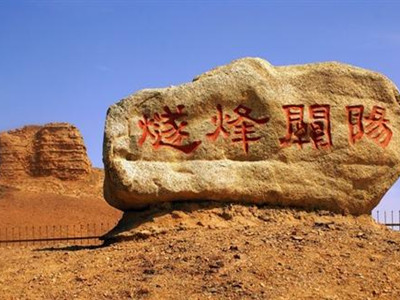Yuangguan Pass [ Related Itinerary ]
 Located along the Hexi Corridor, about 70 kilometers southwest of Dunhuang City, Yangguan Pass played an important role in the transportation between China and other countries during ancient times along the Silk Road. Also, it is one of the two important western passes of the Great Wall in Western Han Dynasty (206BC -24AD).
Located along the Hexi Corridor, about 70 kilometers southwest of Dunhuang City, Yangguan Pass played an important role in the transportation between China and other countries during ancient times along the Silk Road. Also, it is one of the two important western passes of the Great Wall in Western Han Dynasty (206BC -24AD).History of Yangguan Pass
According to the historical records, the Yangguan Pass was originally built by the Emperor Wu of the Han Dynasty to defend against the attacks of other minority nationalities and to develop the area of western regions. The Tang Dynasty (618 - 907) is the boom period of the site. During that period, Yangguan Pass is regarded as a military stronghold, which was an oasis on the sand rich in water. It also welcomed the glorious return of Xuan Zang, a great monk who pilgrimaged to the western countries in search of the Buddhist scriptures. However with the decline of the Silk Road in the Song (960 - 1279) and Ming (1368 - 1644) Dynasties, the Yangguan Pass lost its previous aureole and was forgotten by people.
Appearance of Yangguan Pass
As located in the desert, the Yangguan Pass has been eroded by the flowing dunes year after year. So until now, it has changed into a broken beacon tower with 15.4 feet high and 8.7 yards wide, standing in the boundless desert lonely. Because of the harsh climate, it is hard to have any walls in sight, only with some foundations of the walls. To the south of the pass there is an expanse with an area of 20 square kilometers where contains millions of pieces of broken tile. To the north of the pass, there is a "Curio Beach", actually a small valley where you can find lots of dynasties' tiles, coins, weapons, and decorations. For the "Curio Beach", there is a legend. It is said that once the trousseau of a princess of the Tang dynasty was buried here by a sudden sandstorm, so the locals call it "Curio Beach". The remaining relics here present the evidence of civilization here.
Nowadays, the area around Yangguan Pass has become the last grape planting base in northwest China. So the Yangguan Pass is not only a historic place to remind the past, but also a hometown to taste of the sweet grapes.
Related Itinerary